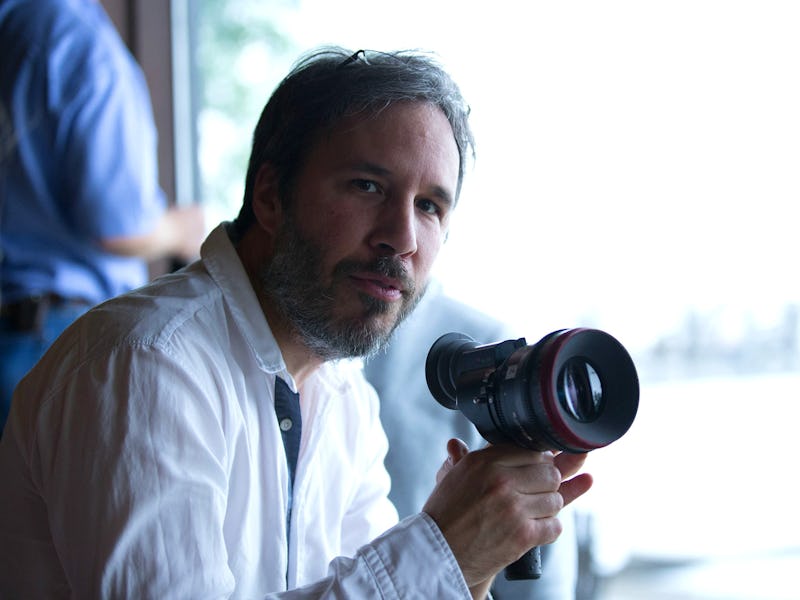How 'Arrival' Proves Denis Villeneuve Can Handle 'Blade Runner 2'
The Canadian director is essentially the new Ridley Scott.

Filmmaker Denis Villeneuve has gone from making Canadian indie cinema to Hollywood stardom in less than a decade. Now, he’s in uncharted territory. His first sci-fi film, Arrival, hits theaters this weekend, and it seems like a hard sell. It stars Amy Adams as a grieving linguist plucked from academia to help try and communicate with extraterrestrial visitors that have landed on earth in gigantic oval spaceships. Behind its blockbuster veneer is an elliptical, almost explosion-free exploration on memory, time, and accepting death.
It’s heady stuff, and it could have come seriously undone were it not for Villeneuve’s immense talent. And he’ll need all that talent for his next project: A sequel to director Ridley Scott’s certified sci-fi classic, Blade Runner. But weirdly enough, Arrival proves that Villeneuve is the perfect choice for following up one of the most influential genre films of all time. Here’s why:
Character
Arrival is that rare example of a big movie working through big genre tropes that resonates most on a subdued character level. It’s supposed to be an alien invasion movie, but Villeneuve wisely wasn’t actually all that interested in the tentacled creatures from another world. Part of this lies in impeccable casting.
Amy Adams delivers a steadfast performance as Louise Banks, the academic linguist hero. The movie could have simply been a dramatic retelling of a college lecture, but her narrative tension is anchored to hazy, fractured memories of her dead daughter, which highlights one of the movie’s biggest revelations. Yet, these big moments that match the size of the story being told never feel cheap, precisely because of Adams’s determination and Villeneuve’s deft hand in teasing out the individual among all the genre flair.
The first Blade Runner movie is a notoriously stylized and grandiose story, and it isn’t exactly known for its robust character work. But, with equally impeccable casting — like Harrison Ford returning as the possible replicant Rick Deckard and Ryan Gosling joining up in an undisclosed role — it’s an area where Villeneuve’s talents could actually improve on the original.
Distinct Visuals
Arrival is deceptive. It’s shot in such a naturalistic way that it’s easy to write off how it uses its patient, symmetrical aesthetic to express the movie’s themes of isolation and separation. At times, cinematographer Bradford Young’s compositions in Arrival almost look like he shot the movie in black and white. Characters are often in shadow, out of focus, or in extreme close-up. If you ever wanted to see Jeremy Renner’s face at a very intimate angle, Arrival is your movie.
The first Blade Runner movie almost basked a little too much in its grimy tech-noir opulence. For the sequel, Villeneuve has tapped veteran cinematographer Roger Deakins to recreate the neon futurism of the original that has almost become de rigueur for similar sci-fi tales. Villeneuve’s ability to embrace a distinct design but not let it overpower the movie will do a great service to Blade Runner 2049.
Accessible Hard Sci-Fi
Arrival sounds like a very bad movie when you try to explain it to people. You inevitably find yourself describing it as the anti-Independence Day: It’s a movie almost entirely made up of scenes of a college professor trying to talk to aliens. Yet, for such a bland description, Villeneuve stays committed to screenwriter Eric Heisserer’s adaptation of author Ted Chiang’s short story source material.
Despite the grim prospect of a movie trying to mesh hard sci-fi with linguistics and make it interesting enough to carry a whole movie, it works. Arrival feels remarkably accessible, despite dealing with dense academic concepts the average moviegoer knows nothing about, in a studio film no less. Villeneuve needs to perform a similar if not as academic feat continuing the Blade Runner story.
Music
The soundscapes of the original Blade Runner loom large in sci-fi fandom. Written and performed by electronic music maestro Vangelis, its synth-based abstract melodies perfectly matched the film’s bleak prospective future.
The same could be said of Icelandic composer Jóhann Jóhannsson’s stirring sounds accompanying Arrival. Guttural, dissonant, and engrossing, Jóhannsson’s otherworldly music seems exactly like the type of harmonics that would be floating around an alien ship if you ever happen to find yourself there. It complements the tension of the film’s opening acts, and supports the emotional undercurrents of the climax. Villeneuve has recruited Jóhannsson — who was nominated for an Oscar for Villeneuve’s previous film, Sicario — to provide the inevitably cacophonous music for Blade Runner 2049. If there’s ever someone whose work could live up to Vangelis, Jóhannsson would be at the top of the list.
Auteurship
Ridley Scott became a filmmaker to watch after making Alien. He became an auteur after making Blade Runner. Villeneuve has followed a similar if not more prolonged path to auteurship after cutting his teeth on sobering French-language dramas like Polytechnique and Incendies before emerging as a fascinating studio filmmaker with films like Prisoners and Sicario. These are big, complicated movies made within the Hollywood machine that still retain a personal stamp.
Villeneuve’s career has certainly led to Arrival, a big studio film that nevertheless has a singular vision, one that culls together his direction, the cinematography, the score, and more to make a solid case for his spot alongside Nolan’s. Going into Blade Runner 2049, Villeneuve is powerful enough to step out on his own.